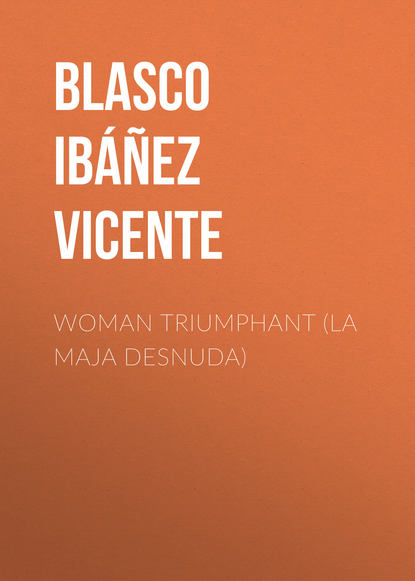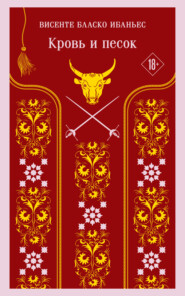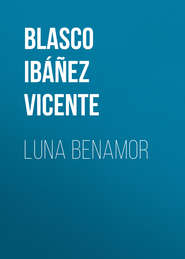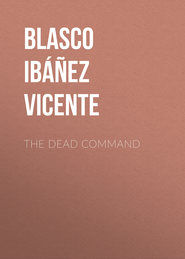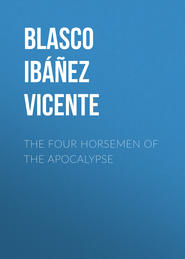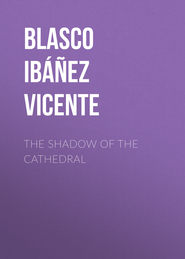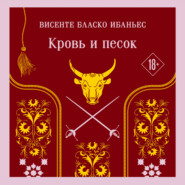По всем вопросам обращайтесь на: info@litportal.ru
(©) 2003-2024.
✖
Woman Triumphant (La Maja Desnuda)
Настройки чтения
Размер шрифта
Высота строк
Поля
Woman Triumphant (La Maja Desnuda)
Vicente Blasco Ibáñez
Vicente Blasco Ibáñez
Woman Triumphant (La Maja Desnuda)
INTRODUCTORY NOTE TO THE ENGLISH TRANSLATION
The title of this novel in the original, La maja desnuda, "The Nude Maja," is also the name of one of the most famous pictures of the great Spanish painter Francisco Goya.
The word maja has no exact equivalent in English or in any of the modern languages. Literally, it means "bedecked," "showy," "gaudily attired," "flashy," "dazzling," etc., and it was applied at the end of the eighteenth century and at the beginning of the nineteenth to a certain class of gay women of the lower strata of Madrid society notorious for their love of dancing and their fondness for exhibiting themselves conspicuously at bull-fights and all popular celebrations. The great ladies of the aristocracy affected the free ways and imitated the picturesque dress of the maja; Goya made this type the central figure of many of his genre paintings, and the dramatist Ramón de la Cruz based most of his sainetes—farcical pieces in one act—upon the customs and rivalries of these women. The dress invented by the maja, consisting of a short skirt partly covered by a net with berry-shaped tassels, white mantilla and high shell-comb, is considered all over the world as the national costume of Spanish women.
When the novel first appeared in Spain some years ago, a certain part of the Madrid public, unduly evil-minded, thought that it had discovered the identity of the real persons whom I had taken as models to draw my characters. This claim provoked a scandalous sensation and gave my book an unwholesome notoriety. It was thought that the protagonists of La maja desnuda were an illustrious Spanish painter of world-wide fame, who is my friend, and an aristocratic lady very celebrated at the time but now forgotten. I protested against this unwarranted and fantastic interpretation. Although I draw my characters from life, I do so only in a very fragmentary way (like all the great creative novelists whom I admire as masters in the field of fiction), using the materials gathered in my observations to form completely new types which are the direct and legitimate offspring of my own imagination. To use a figure: as a novelist I am a painter, not a photographer. Although I seek my inspiration in reality, I copy it in accordance with my own way of seeing it; I do not reproduce it with the mechanical servility of the photographic camera.
It is possible that my imaginary heroes are vaguely reminiscent of beings who actually exist. Subconsciousness is the novelist's principal instrument, and this subconsciousness frequently mocks us, leading us to mistake for our own creation the things which we have unwittingly observed in Nature. But despite this, it is unfair, as well as risky, for the reader to assign the names of real persons to the characters of fiction, saying, "This is So-and-so."
It would be equally unfair to consider this novel as audacious or of doubtful morality. The artistic world which I describe in La maja desnuda cannot be expected to have the same conception of life as the conventional world. Far from believing it immoral, I consider this one of the most moral novels I have ever written. And it is for this reason that, with a full realization of the standards demanded by the English-reading public, I have not hesitated to authorize the present translation without palliation or amputation, fully convinced that the reader will not find anything in this novel objectionable or offensive to his moral sense. Morality is not to be found in words but in deeds and in the lessons which these deeds teach.
The difficulty of adequately translating the word maja into English led to the adoption of "Woman Triumphant" as the title of the present version. I believe it is a happy selection; it interprets the spirit of the novel. But it must be borne in mind that the woman here is the wife of the protagonist. It is the wife who triumphs, resurrecting in spirit to exert an overwhelming influence over the life of a man who had wished to live without her.
Renovales, the hero, is simply the personification of human desire, this poor desire which, in reality, does not know what it wants, eternally fickle and unsatisfied. When we finally obtain what we desire, it does not seem enough. "More: I want more," we say. If we lose something that made life unbearable, we immediately wish it back as indispensable to our happiness. Such are we: poor deluded children who cried yesterday for what we scorn to-day and shall want again to-morrow; poor deluded beings plunging across the span of life on the Icarian wings of caprice.
Vicente Blasco Ibañez.
New York, January, 1920.
WOMAN TRIUMPHANT
PART I
I
It was eleven o'clock in the morning when Mariano Renovales reached the Museo del Prado. Several years had passed since the famous painter had entered it. The dead did not attract him; very interesting they were, very worthy of respect, under the glorious shroud of the centuries, but art was moving along new paths and he could not study there under the false glare of the skylights, where he saw reality only through the temperaments of other men. A bit of sea, a mountainside, a group of ragged people, an expressive head attracted him more than that palace, with its broad staircases, its white columns and its statues of bronze and alabaster—a solemn pantheon of art, where the neophytes vacillated in fruitless confusion, without knowing what course to follow.
The master Renovales stopped for a few moments at the foot of the stairway. He contemplated the valley through which you approach the palace—with its slopes of fresh turf, dotted at intervals with the sickly little trees—with a certain emotion, as men are wont to contemplate, after a long absence, the places familiar to their youth. Above the scattered growth the ancient church of Los Jerónimos, with its gothic masonry, outlined against the blue sky its twin towers and ruined arcades. The wintry foliage of the Retiro served as a background for the white mass of the Casón. Renovales thought of the frescos of Giordano that decorated its ceilings. Afterwards, he fixed his attention on a building with red walls and a stone portal, which pretentiously obstructed the space in the foreground, at the edge of the green slope. Bah! The Academy! And the artist's sneer included in the same loathing the Academy of Language and the other Academies—painting, literature, every manifestation of human thought, dried, smoked, and swathed, with the immortality of a mummy, in the bandages of tradition, rules, and respect for precedent.
A gust of icy wind shook the skirts of his overcoat, his long beard tinged with gray and his wide felt hat, beneath the brim of which protruded the heavy locks of his hair, that had excited so much comment in his youth, but which had gradually grown shorter with prudent trimming, as the master rose in the world, winning fame and money.
Renovales felt cold in the damp valley. It was one of those bright, freezing days that are so frequent in the winter in Madrid. The sun was shining; the sky was blue; but from the mountains, covered with snow, came an icy wind, that hardened the ground, making it as brittle as glass. In the corners, where the warmth of the sun did not reach, the morning frost still glistened like a coating of sugar. On the mossy carpet, the sparrows, thin with the privations of winter, trotted back and forth like children, shaking their bedraggled feathers.
The stairway of the Museo recalled to the master his early youth, when at sixteen he had climbed those steps many a time with his stomach faint from the wretched meal at the boarding-house. How many mornings he had spent in that old building copying Velásquez! The place brought to his memory his dead hopes, a host of illusions that now made his smile; recollections of hunger and humiliating bargaining to make his first money by the sale of copies. His large, stern face, his brow that filled his pupils and admirers with terror lighted up with a merry smile. He recalled how he used to go into the Museo with halting steps, how he feared to leave the easel, lest people might notice the gaping soles of his boots that left his feet uncovered.
He passed through the vestibule and opened the first glass door. Instantly the noises of the world outside ceased; the rattling of the carriages in the Prado; the bells of the street-cars, the dull rumble of the carts, the shrill cries of the children who were running about on the slopes. He opened the second door, and his face, swollen by the cold, felt the caress of warm air, buzzing with the vague hum of silence. The footfalls of the visitors reverberated in the manner peculiar to large, unoccupied buildings. The slam of the door, as it closed, resounded like a cannon shot, passing from hall to hall through the heavy curtains. From the gratings of the registers poured the invisible breath of the furnaces. The people, on entering, spoke in a low tone, as if they were in a cathedral; their faces assumed an expression of unnatural seriousness, as though they were intimidated by the thousands of canvases that lined the walls, by the enormous busts that decorated the circle of the rotunda and the middle of the central salon.
On seeing Renovales, the two door-keepers, in their long frock-coats, started to their feet. They did not know who he was, but he certainly was somebody. They had often seen that face, perhaps in the newspapers, perhaps on match-boxes. It was associated in their minds with the glory of popularity, with the high honors reserved for people of distinction. Presently they recognized him. It was so many years since they had seen him there! And the two attendants, with their caps covered with gold-braid in their hands and with an obsequious smile, came forward towards the great artist.
"Good morning, Don Mariano. Did Señor de Renovales wish something? Did he want them to call the curator?" They spoke with oily obsequiousness, with the confusion of courtiers who see a foreign sovereign suddenly enter their palace, recognizing him through his disguise.
Renovales rid himself of them with a brusque gesture and cast a glance over the large decorative canvases of the rotunda, that recalled the wars of the 17th century; generals with bristling mustaches and plumed slouch-hat, directing the battle with a short baton, as though they were directing an orchestra, troops of arquebusiers disappearing downhill with banners of red and blue crosses at their front, forests of pikes rising from the smoke, green meadows of Flanders in the backgrounds—thundering, fruitless combats that were almost the last gasps of a Spain of European influence. He lifted a heavy curtain and entered the spacious salon, where the people at the other end looked like little wax figures under the dull illumination of the skylights.
The artist continued straight ahead, scarcely noticing the pictures, old acquaintances that could tell him nothing new. His eyes sought the people without, however, finding in them any greater novelty. It seemed as though they formed a part of the building and had not moved from it in many years; good-natured fathers with a group of children before their knees, explaining the meaning of the pictures; a school teacher, with her well-behaved and silent pupils who, in obedience to the command of their superior, passed without stopping before the lightly clad saints; a gentleman with two priests, talking loudly, to show that he was intelligent and almost at home there; several foreign ladies with their veils caught up over their straw hats and their coats on their arms, consulting the catalogue, all with a sort of family-air, with identical expressions of admiration and curiosity, until Renovales wondered if they were the same ones he had seen there years before, the last time he was there.
As he passed, he greeted the great masters mentally; on one side the holy figures of El Greco, with their greenish or bluish spirituality, slender and undulating; beyond, the wrinkled, black heads of Ribera, with ferocious expressions of torture and pain—marvelous artists, whom Renovales admired, while determined not to imitate them. Afterwards, between the railing that protects the pictures and the line of busts, show-cases and marble tables supported by gilded lions, he came upon the easels of several copyists. They were boys from the School of Fine Arts, or poverty-stricken young ladies with run-down heels and dilapidated hats, who were copying Murillos. They were tracing on the canvas the blue of the Virgin's robe or the plump flesh of the curly-haired boys that played with the Divine Lamb. Their copies were commissions from pious people; a genre that found an easy sale among the benefactors of convents and oratories. The smoke of the candles, the wear of years, the blindness of devotion would dim the colors, and some day the eyes of the worshipers, weeping in supplication, would see the celestial figures move with mysterious life on their blackened background, as they implored from them wondrous miracles.
The master made his way toward the Hall of Velásquez. It was there that his friend Tekli was working. His visit to the Museo had no other object than to see the copy that the Hungarian painter was making of the picture of Las Meninas.
The day before, when the foreigner was announced in his studio, he had remained perplexed for a long while, looking at the name on the card. Tekli! And then all at once he remembered a friend of twenty years before, when he lived in Rome; a good-natured Hungarian, who admired him sincerely and who made up for his lack of genius with a silent persistency in his work, like a beast of burden.
Renovales was glad to see his little blue eyes, hidden under his thin, silky eyebrows, his jaw, protruding like a shovel, a feature that made him look very much like the Austrian monarchs—his tall frame that bent forward under the impulse of excitement, while he stretched out his bony arms, long as tentacles, and greeted him in Italian:
"Oh, maestro, caro maestro!"
He had taken refuge in a professorship, like all artists who lack the power to continue the upward climb, who fall in the rut. Renovales recognized the artist-official in his spotless suit, dark and proper, in his dignified glance that rested from time to time on his shining boots that seemed to reflect the whole studio. He even wore on one lapel of his coat the variegated button of some mysterious decoration. The felt hat, white as meringue, which he held in his hand, was the only discordant feature in this general effect of a public functionary. Renovales caught his hands with sincere enthusiasm. The famous Tekli! How glad he was to see him! What times they used to have in Rome! And with a smile of kindly superiority he listened to the story of his success. He was a professor in Budapest; every year he saved money in order to go and study in some celebrated European museum. At last he had succeeded in coming to Spain, fulfilling the desire he had cherished for many years.
"Oh, Velásquez! uel maestro, caro Mariano!"
And throwing back his head, with a dreamy expression in his eyes, he moved his protruding jaw covered with reddish hair, with a voluptuous look, as though he were sipping a glass of his sweet native Tokay.
He had been in Madrid for a month, working every morning in the Museo. His copy of Las Meninas was almost finished. He had not been to see his "Dear Mariano" sooner because he wanted to show him this work. Would he come and see him some morning in the Museo? Would he give him this proof of his friendship? Renovales tried to decline. What did he care for a copy? But there was an expression of such humble supplication in the Hungarian's little eyes, he showered him with so many praises of his great triumphs, expatiating on the success that his picture Man Overboard! had won at the last Budapest Exhibition, that the master promised to go to the Museo.
And a few days later, one morning when a gentleman whose portrait he was painting canceled his appointment, Renovales remembered his promise and went to the Museo del Prado, feeling, as he entered, the same sensation of insignificance and homesickness that a man suffers on returning to the university where he has passed his youth.
When he found himself in the Hall of Velásquez, he suddenly felt seized with religious respect. There was a painter! The painter! All his irreverent theories of hatred for the dead were left outside the door. The charm of those canvases that he had not seen for many years rose again—fresh, powerful, irresistible; it overwhelmed him, awakening his remorse. For a long time he remained motionless, turning his eyes from one picture to another, eager to comprise in one glance the whole work of the immortal, while around him the hum of curiosity began again.
"Renovales! That's Renovales!"
The news had started from the door, spreading through the whole Museo, reaching the Hall of Velásquez behind his steps. The groups of curious people stopped gazing at the pictures to look at that huge, self-possessed man who did not seem to realize the curiosity that surrounded him. The ladies, as they went from canvas to canvas, looked out of the corner of their eyes at the celebrated artist whose portrait they had seen so often. They found him more ugly, more commonplace than he appeared in the engravings in the papers. It did not seem possible that that "porter" had talent and painted women so well. Some young fellows approached to look at him more closely, pretending to gaze at the same pictures as the master. They scrutinized him, noting his external peculiarities with that desire for enthusiastic imitation which marks the novice. Some determined to copy his soft bow-tie and his tangled hair, with the fantastic hope that this would give them a new spirit for painting. Others complained to themselves that they were beardless and could not display the curly gray whiskers of the famous master.
He, with his keen sensitiveness to praise, was not long in observing the atmosphere of curiosity that surrounded him. The young copyists seemed to stick closer to their easels, knitted their brows, dilated their nostrils, and moved their brushes slowly, with hesitation, knowing that he was behind them, trembling at every step that sounded on the inlaid floor, full of fear and desire that he might deign to cast a glance over their shoulders. He divined with a sort of pride what all the mouths were whispering, what all the eyes were saying, fixed absent-mindedly on the canvases only to turn toward him.
"It's Renovales—the painter Renovales."
The master looked for a long while at one of the copyists—an old man, decrepit and almost blind, with heavy convex spectacles that gave him the appearance of a sea-monster, whose hands trembled with senile unsteadiness. Renovales recognized him. Twenty years before, when he used to study in the Museo, he had seen him in the same spot, always copying Los Borrachos. Even if he should become completely blind, if the picture should be lost, he could reproduce it by feeling. In those days they had often talked together, but the poor man could not have the remotest suspicion that the Renovales whom people talked so much about was the same lad who on more than one occasion had borrowed a brush from him, but whose memory was scarcely preserved in his mind, mummified by eternal imitation.
Renovales thought of the kindness of the chummy Bacchus and the gang of ruffians of his court, who for half a century had been supporting the household of the copyist, and he fancied he could see the old wife, the married children, the grandchildren—a whole family supported by the old man's trembling hand.
Some one whispered to him the news that was filling the Museo with excitement and the copyist, shrugging his shoulders disdainfully, raised his moribund glance from his work.
And so Renovales was there, the famous Renovales! At last he was going to see the prodigy!
The master saw those grotesque eyes like those of a sea-monster, fixed on him, with an ironical gleam behind the heavy lenses. The grafter! He had already heard of that studio, as splendid as a palace, behind the Retire What Renovales had in such plenty had been taken from men like him who, for want of influence, had been left behind. He charged thousands of dollars for a canvas, when Velásquez worked for three pesetas a day and Goya painted his portraits for a couple of doubloons. Deceit, modernism, the audacity of the younger generation that lacked scruples, the ignorance of the simpletons that believe the newspapers! The only good thing was right there before him. And once more shrugging his shoulders scornfully, he lost his expression of ironical protest and returned to his thousandth copy of Los Borrachos.
Renovales, seeing that the curiosity about him was diminishing, entered the little hall that contained the picture of Las Meninas. There was Tekli in front of the famous canvas that occupies the whole back of the room, seated before his easel, with his white hat pushed back to leave free his throbbing brow that was contracted with a tenacious insistence on accuracy.
Seeing Renovales, he rose hastily, leaving his palette on the piece of oil-cloth that protected the floor from spots of paint. Dear master! How thankful he was to him for this visit! And he showed him the copy, minutely accurate but without the wonderful atmosphere, without the miraculous realism of the original. Renovales approved with a nod; he admired the patient toil of that gentle ox of art, whose furrows were always alike, of geometric precision, without the slightest negligence or the least attempt at originality.
"Ti piace?" he asked anxiously, looking into his eyes to divine his thoughts. "È vero? È vero?" he repeated with the uncertainty of a child who fears that he is being deceived.
And suddenly calmed by the evidences of Renovales' approval, that kept growing more extravagant to conceal his indifference, the Hungarian grasped both of his hands and lifted them to his breast.
Vicente Blasco Ibáñez
Vicente Blasco Ibáñez
Woman Triumphant (La Maja Desnuda)
INTRODUCTORY NOTE TO THE ENGLISH TRANSLATION
The title of this novel in the original, La maja desnuda, "The Nude Maja," is also the name of one of the most famous pictures of the great Spanish painter Francisco Goya.
The word maja has no exact equivalent in English or in any of the modern languages. Literally, it means "bedecked," "showy," "gaudily attired," "flashy," "dazzling," etc., and it was applied at the end of the eighteenth century and at the beginning of the nineteenth to a certain class of gay women of the lower strata of Madrid society notorious for their love of dancing and their fondness for exhibiting themselves conspicuously at bull-fights and all popular celebrations. The great ladies of the aristocracy affected the free ways and imitated the picturesque dress of the maja; Goya made this type the central figure of many of his genre paintings, and the dramatist Ramón de la Cruz based most of his sainetes—farcical pieces in one act—upon the customs and rivalries of these women. The dress invented by the maja, consisting of a short skirt partly covered by a net with berry-shaped tassels, white mantilla and high shell-comb, is considered all over the world as the national costume of Spanish women.
When the novel first appeared in Spain some years ago, a certain part of the Madrid public, unduly evil-minded, thought that it had discovered the identity of the real persons whom I had taken as models to draw my characters. This claim provoked a scandalous sensation and gave my book an unwholesome notoriety. It was thought that the protagonists of La maja desnuda were an illustrious Spanish painter of world-wide fame, who is my friend, and an aristocratic lady very celebrated at the time but now forgotten. I protested against this unwarranted and fantastic interpretation. Although I draw my characters from life, I do so only in a very fragmentary way (like all the great creative novelists whom I admire as masters in the field of fiction), using the materials gathered in my observations to form completely new types which are the direct and legitimate offspring of my own imagination. To use a figure: as a novelist I am a painter, not a photographer. Although I seek my inspiration in reality, I copy it in accordance with my own way of seeing it; I do not reproduce it with the mechanical servility of the photographic camera.
It is possible that my imaginary heroes are vaguely reminiscent of beings who actually exist. Subconsciousness is the novelist's principal instrument, and this subconsciousness frequently mocks us, leading us to mistake for our own creation the things which we have unwittingly observed in Nature. But despite this, it is unfair, as well as risky, for the reader to assign the names of real persons to the characters of fiction, saying, "This is So-and-so."
It would be equally unfair to consider this novel as audacious or of doubtful morality. The artistic world which I describe in La maja desnuda cannot be expected to have the same conception of life as the conventional world. Far from believing it immoral, I consider this one of the most moral novels I have ever written. And it is for this reason that, with a full realization of the standards demanded by the English-reading public, I have not hesitated to authorize the present translation without palliation or amputation, fully convinced that the reader will not find anything in this novel objectionable or offensive to his moral sense. Morality is not to be found in words but in deeds and in the lessons which these deeds teach.
The difficulty of adequately translating the word maja into English led to the adoption of "Woman Triumphant" as the title of the present version. I believe it is a happy selection; it interprets the spirit of the novel. But it must be borne in mind that the woman here is the wife of the protagonist. It is the wife who triumphs, resurrecting in spirit to exert an overwhelming influence over the life of a man who had wished to live without her.
Renovales, the hero, is simply the personification of human desire, this poor desire which, in reality, does not know what it wants, eternally fickle and unsatisfied. When we finally obtain what we desire, it does not seem enough. "More: I want more," we say. If we lose something that made life unbearable, we immediately wish it back as indispensable to our happiness. Such are we: poor deluded children who cried yesterday for what we scorn to-day and shall want again to-morrow; poor deluded beings plunging across the span of life on the Icarian wings of caprice.
Vicente Blasco Ibañez.
New York, January, 1920.
WOMAN TRIUMPHANT
PART I
I
It was eleven o'clock in the morning when Mariano Renovales reached the Museo del Prado. Several years had passed since the famous painter had entered it. The dead did not attract him; very interesting they were, very worthy of respect, under the glorious shroud of the centuries, but art was moving along new paths and he could not study there under the false glare of the skylights, where he saw reality only through the temperaments of other men. A bit of sea, a mountainside, a group of ragged people, an expressive head attracted him more than that palace, with its broad staircases, its white columns and its statues of bronze and alabaster—a solemn pantheon of art, where the neophytes vacillated in fruitless confusion, without knowing what course to follow.
The master Renovales stopped for a few moments at the foot of the stairway. He contemplated the valley through which you approach the palace—with its slopes of fresh turf, dotted at intervals with the sickly little trees—with a certain emotion, as men are wont to contemplate, after a long absence, the places familiar to their youth. Above the scattered growth the ancient church of Los Jerónimos, with its gothic masonry, outlined against the blue sky its twin towers and ruined arcades. The wintry foliage of the Retiro served as a background for the white mass of the Casón. Renovales thought of the frescos of Giordano that decorated its ceilings. Afterwards, he fixed his attention on a building with red walls and a stone portal, which pretentiously obstructed the space in the foreground, at the edge of the green slope. Bah! The Academy! And the artist's sneer included in the same loathing the Academy of Language and the other Academies—painting, literature, every manifestation of human thought, dried, smoked, and swathed, with the immortality of a mummy, in the bandages of tradition, rules, and respect for precedent.
A gust of icy wind shook the skirts of his overcoat, his long beard tinged with gray and his wide felt hat, beneath the brim of which protruded the heavy locks of his hair, that had excited so much comment in his youth, but which had gradually grown shorter with prudent trimming, as the master rose in the world, winning fame and money.
Renovales felt cold in the damp valley. It was one of those bright, freezing days that are so frequent in the winter in Madrid. The sun was shining; the sky was blue; but from the mountains, covered with snow, came an icy wind, that hardened the ground, making it as brittle as glass. In the corners, where the warmth of the sun did not reach, the morning frost still glistened like a coating of sugar. On the mossy carpet, the sparrows, thin with the privations of winter, trotted back and forth like children, shaking their bedraggled feathers.
The stairway of the Museo recalled to the master his early youth, when at sixteen he had climbed those steps many a time with his stomach faint from the wretched meal at the boarding-house. How many mornings he had spent in that old building copying Velásquez! The place brought to his memory his dead hopes, a host of illusions that now made his smile; recollections of hunger and humiliating bargaining to make his first money by the sale of copies. His large, stern face, his brow that filled his pupils and admirers with terror lighted up with a merry smile. He recalled how he used to go into the Museo with halting steps, how he feared to leave the easel, lest people might notice the gaping soles of his boots that left his feet uncovered.
He passed through the vestibule and opened the first glass door. Instantly the noises of the world outside ceased; the rattling of the carriages in the Prado; the bells of the street-cars, the dull rumble of the carts, the shrill cries of the children who were running about on the slopes. He opened the second door, and his face, swollen by the cold, felt the caress of warm air, buzzing with the vague hum of silence. The footfalls of the visitors reverberated in the manner peculiar to large, unoccupied buildings. The slam of the door, as it closed, resounded like a cannon shot, passing from hall to hall through the heavy curtains. From the gratings of the registers poured the invisible breath of the furnaces. The people, on entering, spoke in a low tone, as if they were in a cathedral; their faces assumed an expression of unnatural seriousness, as though they were intimidated by the thousands of canvases that lined the walls, by the enormous busts that decorated the circle of the rotunda and the middle of the central salon.
On seeing Renovales, the two door-keepers, in their long frock-coats, started to their feet. They did not know who he was, but he certainly was somebody. They had often seen that face, perhaps in the newspapers, perhaps on match-boxes. It was associated in their minds with the glory of popularity, with the high honors reserved for people of distinction. Presently they recognized him. It was so many years since they had seen him there! And the two attendants, with their caps covered with gold-braid in their hands and with an obsequious smile, came forward towards the great artist.
"Good morning, Don Mariano. Did Señor de Renovales wish something? Did he want them to call the curator?" They spoke with oily obsequiousness, with the confusion of courtiers who see a foreign sovereign suddenly enter their palace, recognizing him through his disguise.
Renovales rid himself of them with a brusque gesture and cast a glance over the large decorative canvases of the rotunda, that recalled the wars of the 17th century; generals with bristling mustaches and plumed slouch-hat, directing the battle with a short baton, as though they were directing an orchestra, troops of arquebusiers disappearing downhill with banners of red and blue crosses at their front, forests of pikes rising from the smoke, green meadows of Flanders in the backgrounds—thundering, fruitless combats that were almost the last gasps of a Spain of European influence. He lifted a heavy curtain and entered the spacious salon, where the people at the other end looked like little wax figures under the dull illumination of the skylights.
The artist continued straight ahead, scarcely noticing the pictures, old acquaintances that could tell him nothing new. His eyes sought the people without, however, finding in them any greater novelty. It seemed as though they formed a part of the building and had not moved from it in many years; good-natured fathers with a group of children before their knees, explaining the meaning of the pictures; a school teacher, with her well-behaved and silent pupils who, in obedience to the command of their superior, passed without stopping before the lightly clad saints; a gentleman with two priests, talking loudly, to show that he was intelligent and almost at home there; several foreign ladies with their veils caught up over their straw hats and their coats on their arms, consulting the catalogue, all with a sort of family-air, with identical expressions of admiration and curiosity, until Renovales wondered if they were the same ones he had seen there years before, the last time he was there.
As he passed, he greeted the great masters mentally; on one side the holy figures of El Greco, with their greenish or bluish spirituality, slender and undulating; beyond, the wrinkled, black heads of Ribera, with ferocious expressions of torture and pain—marvelous artists, whom Renovales admired, while determined not to imitate them. Afterwards, between the railing that protects the pictures and the line of busts, show-cases and marble tables supported by gilded lions, he came upon the easels of several copyists. They were boys from the School of Fine Arts, or poverty-stricken young ladies with run-down heels and dilapidated hats, who were copying Murillos. They were tracing on the canvas the blue of the Virgin's robe or the plump flesh of the curly-haired boys that played with the Divine Lamb. Their copies were commissions from pious people; a genre that found an easy sale among the benefactors of convents and oratories. The smoke of the candles, the wear of years, the blindness of devotion would dim the colors, and some day the eyes of the worshipers, weeping in supplication, would see the celestial figures move with mysterious life on their blackened background, as they implored from them wondrous miracles.
The master made his way toward the Hall of Velásquez. It was there that his friend Tekli was working. His visit to the Museo had no other object than to see the copy that the Hungarian painter was making of the picture of Las Meninas.
The day before, when the foreigner was announced in his studio, he had remained perplexed for a long while, looking at the name on the card. Tekli! And then all at once he remembered a friend of twenty years before, when he lived in Rome; a good-natured Hungarian, who admired him sincerely and who made up for his lack of genius with a silent persistency in his work, like a beast of burden.
Renovales was glad to see his little blue eyes, hidden under his thin, silky eyebrows, his jaw, protruding like a shovel, a feature that made him look very much like the Austrian monarchs—his tall frame that bent forward under the impulse of excitement, while he stretched out his bony arms, long as tentacles, and greeted him in Italian:
"Oh, maestro, caro maestro!"
He had taken refuge in a professorship, like all artists who lack the power to continue the upward climb, who fall in the rut. Renovales recognized the artist-official in his spotless suit, dark and proper, in his dignified glance that rested from time to time on his shining boots that seemed to reflect the whole studio. He even wore on one lapel of his coat the variegated button of some mysterious decoration. The felt hat, white as meringue, which he held in his hand, was the only discordant feature in this general effect of a public functionary. Renovales caught his hands with sincere enthusiasm. The famous Tekli! How glad he was to see him! What times they used to have in Rome! And with a smile of kindly superiority he listened to the story of his success. He was a professor in Budapest; every year he saved money in order to go and study in some celebrated European museum. At last he had succeeded in coming to Spain, fulfilling the desire he had cherished for many years.
"Oh, Velásquez! uel maestro, caro Mariano!"
And throwing back his head, with a dreamy expression in his eyes, he moved his protruding jaw covered with reddish hair, with a voluptuous look, as though he were sipping a glass of his sweet native Tokay.
He had been in Madrid for a month, working every morning in the Museo. His copy of Las Meninas was almost finished. He had not been to see his "Dear Mariano" sooner because he wanted to show him this work. Would he come and see him some morning in the Museo? Would he give him this proof of his friendship? Renovales tried to decline. What did he care for a copy? But there was an expression of such humble supplication in the Hungarian's little eyes, he showered him with so many praises of his great triumphs, expatiating on the success that his picture Man Overboard! had won at the last Budapest Exhibition, that the master promised to go to the Museo.
And a few days later, one morning when a gentleman whose portrait he was painting canceled his appointment, Renovales remembered his promise and went to the Museo del Prado, feeling, as he entered, the same sensation of insignificance and homesickness that a man suffers on returning to the university where he has passed his youth.
When he found himself in the Hall of Velásquez, he suddenly felt seized with religious respect. There was a painter! The painter! All his irreverent theories of hatred for the dead were left outside the door. The charm of those canvases that he had not seen for many years rose again—fresh, powerful, irresistible; it overwhelmed him, awakening his remorse. For a long time he remained motionless, turning his eyes from one picture to another, eager to comprise in one glance the whole work of the immortal, while around him the hum of curiosity began again.
"Renovales! That's Renovales!"
The news had started from the door, spreading through the whole Museo, reaching the Hall of Velásquez behind his steps. The groups of curious people stopped gazing at the pictures to look at that huge, self-possessed man who did not seem to realize the curiosity that surrounded him. The ladies, as they went from canvas to canvas, looked out of the corner of their eyes at the celebrated artist whose portrait they had seen so often. They found him more ugly, more commonplace than he appeared in the engravings in the papers. It did not seem possible that that "porter" had talent and painted women so well. Some young fellows approached to look at him more closely, pretending to gaze at the same pictures as the master. They scrutinized him, noting his external peculiarities with that desire for enthusiastic imitation which marks the novice. Some determined to copy his soft bow-tie and his tangled hair, with the fantastic hope that this would give them a new spirit for painting. Others complained to themselves that they were beardless and could not display the curly gray whiskers of the famous master.
He, with his keen sensitiveness to praise, was not long in observing the atmosphere of curiosity that surrounded him. The young copyists seemed to stick closer to their easels, knitted their brows, dilated their nostrils, and moved their brushes slowly, with hesitation, knowing that he was behind them, trembling at every step that sounded on the inlaid floor, full of fear and desire that he might deign to cast a glance over their shoulders. He divined with a sort of pride what all the mouths were whispering, what all the eyes were saying, fixed absent-mindedly on the canvases only to turn toward him.
"It's Renovales—the painter Renovales."
The master looked for a long while at one of the copyists—an old man, decrepit and almost blind, with heavy convex spectacles that gave him the appearance of a sea-monster, whose hands trembled with senile unsteadiness. Renovales recognized him. Twenty years before, when he used to study in the Museo, he had seen him in the same spot, always copying Los Borrachos. Even if he should become completely blind, if the picture should be lost, he could reproduce it by feeling. In those days they had often talked together, but the poor man could not have the remotest suspicion that the Renovales whom people talked so much about was the same lad who on more than one occasion had borrowed a brush from him, but whose memory was scarcely preserved in his mind, mummified by eternal imitation.
Renovales thought of the kindness of the chummy Bacchus and the gang of ruffians of his court, who for half a century had been supporting the household of the copyist, and he fancied he could see the old wife, the married children, the grandchildren—a whole family supported by the old man's trembling hand.
Some one whispered to him the news that was filling the Museo with excitement and the copyist, shrugging his shoulders disdainfully, raised his moribund glance from his work.
And so Renovales was there, the famous Renovales! At last he was going to see the prodigy!
The master saw those grotesque eyes like those of a sea-monster, fixed on him, with an ironical gleam behind the heavy lenses. The grafter! He had already heard of that studio, as splendid as a palace, behind the Retire What Renovales had in such plenty had been taken from men like him who, for want of influence, had been left behind. He charged thousands of dollars for a canvas, when Velásquez worked for three pesetas a day and Goya painted his portraits for a couple of doubloons. Deceit, modernism, the audacity of the younger generation that lacked scruples, the ignorance of the simpletons that believe the newspapers! The only good thing was right there before him. And once more shrugging his shoulders scornfully, he lost his expression of ironical protest and returned to his thousandth copy of Los Borrachos.
Renovales, seeing that the curiosity about him was diminishing, entered the little hall that contained the picture of Las Meninas. There was Tekli in front of the famous canvas that occupies the whole back of the room, seated before his easel, with his white hat pushed back to leave free his throbbing brow that was contracted with a tenacious insistence on accuracy.
Seeing Renovales, he rose hastily, leaving his palette on the piece of oil-cloth that protected the floor from spots of paint. Dear master! How thankful he was to him for this visit! And he showed him the copy, minutely accurate but without the wonderful atmosphere, without the miraculous realism of the original. Renovales approved with a nod; he admired the patient toil of that gentle ox of art, whose furrows were always alike, of geometric precision, without the slightest negligence or the least attempt at originality.
"Ti piace?" he asked anxiously, looking into his eyes to divine his thoughts. "È vero? È vero?" he repeated with the uncertainty of a child who fears that he is being deceived.
And suddenly calmed by the evidences of Renovales' approval, that kept growing more extravagant to conceal his indifference, the Hungarian grasped both of his hands and lifted them to his breast.





